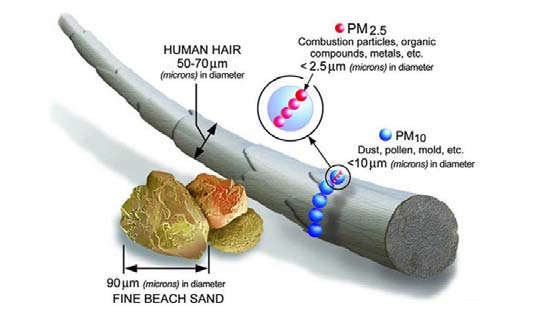About air pollution
Reducing air pollution means healthier people and a healthier environment. The EPA works with Government, industry, community, environment and other stakeholders on strategies to reduce air pollution and improve air quality NSW.
Causes of air pollution
Air pollution is caused by:
- natural sources such as bushfires, dust storms, sea salt and pollen
- domestic activities such as burning wood fires, including using wood heaters, fuel-powered garden equipment, and portable fuel containers
- commercial businesses such as spray painters, printers, quarries, service stations
- industrial activities such as coal mining, oil refining and power generation
- on-road motor vehicles such as buses, cars and trucks
- off-road vehicles and equipment such as dump trucks, bulldozers and marine vessels
Types of air pollution
The main types of air pollution of concern in NSW are ozone pollution and particle pollution.
Ozone pollution
Ozone is a gas that can be found in both the upper atmosphere and at ground level. It is beneficial in the upper atmosphere as it protects us from the sun’s radiation and its absence there is referred to as the ‘ozone hole’. However, it is not beneficial in elevated concentrations at ground level as it causes human health impacts.
Cars and trucks are significant sources of ozone producing pollutants in the Sydney basin. On hot sunny days, ground level ozone pollution forms photochemical smog, which appears as a white atmospheric haze. Ground level ozone is formed from chemical reactions of volatile organic compounds (VOCs) and nitrogen oxides (NOx) taking place in sunlight.
The major human-related sources of VOCs and NOx in NSW include emissions from industrial facilities, power stations, motor vehicle exhausts and fumes from engines in garden equipment and recreational boats as well as paints, aerosols and solvents used in homes and businesses.
Particle pollution
Particle pollution is a mixture of small particles and liquid droplets suspended in air. It is made up of a complex range of components including nitrates, sulphates, organic chemicals, metals, as well as soil or dust.
Key sources of particle pollution include:
- motor vehicles
- diesel equipment
- power stations
- residential wood heaters
- bushfires
- industrial processes
Particles are either:
- emitted directly from their source, or
- formed in the atmosphere through chemical reactions, such as those involving gases emitted from power plants, industries and motor vehicles.
During the cooler months of the year, cold air can trap this pollution close to the ground where it is seen as a layer of brown haze.
Particles can be referred to in a number of different ways depending on their size and composition.
PM10 pollution
- is made up of particles of less than 10 micrometres (µm) in diameter
- includes PM2.5 pollution which comprises tiny particles of less than 2.5 µm in diameter
- includes particles from vehicles on dirt roads and dusty industrial activities such as mining, crushing and grinding.
PM2.5 pollution
- is made up of substances from different sources and processes, including sea salt spray, atmospheric chemical reactions and combustion
- in winter in Sydney and some regional centres is mainly caused by domestic wood heaters which create smoke from solid fuel combustion.
Primary particulate matter pollution consists of PM10 and PM2.5 emissions
Secondary particulate matter pollution consists of NOx, VOC, sulphur dioxide (SO2) and ammonia which react in the atmosphere to form secondary organic aerosols, nitrate and sulfate compounds.
Fine particulate matter pollution is made up of both primary and secondary particulate matter pollution.
Read more about managing particle pollution.
Movement of air pollution
Geography and weather influence the concentration and dispersal of air pollution. In Sydney, for example, the city’s basin shape can trap air pollution. In summer, cool overnight air drains from the hills towards the sea, picking up pollution from vehicles, industry and homes. Morning sea breezes then push it back over urban areas where it collects more pollution and creates smog.
This weather pattern can be repeated for days at a time, until rain or strong winds clear the pollution away.
Health effects of air pollution
Smog-forming ozone pollution can cause breathlessness, respiratory difficulties, chest pain, irritation of the airways and congestion.
Particle pollution can pass through the throat and nose and enter the lungs, where the particles can cause respiratory and circulation problems, particularly in older adults, children, and people with existing health conditions. (Read more on particle pollution health impacts.)
Australian air quality and reporting standards are set by the National Environment Protection Council (NEPC) under the National Environment Protection (Ambient Air Quality) Measure (Ambient Air Quality NEPM).
The Ambient Air Quality NEPM sets air quality standards for six common pollutants
- carbon monoxide (CO)
- lead
- nitrogen dioxide (NO2)
- ozone (O3)
- particles (PM10 and PM2.5)
- SO2
Air pollution levels in NSW are continuously monitored by the Office of Environment and Heritage (OEH) through the NSW ambient air quality monitoring network. Data from the network is updated hourly and is publicly available on the OEH website at Current and forecast air quality.
The Ambient Air Quality NEPM standards were updated in 2015 to include more stringent reporting requirements for particles.
